Strategies for Helping Students in Individual Learning
VerifiedAdded on 2023/01/05
|15
|5159
|6
AI Summary
This article discusses the strategies used in helping students in individual learning. It explores the importance of choosing the right strategies for maximum impact and provides expert guidance from Desklib.
Contribute Materials
Your contribution can guide someone’s learning journey. Share your
documents today.
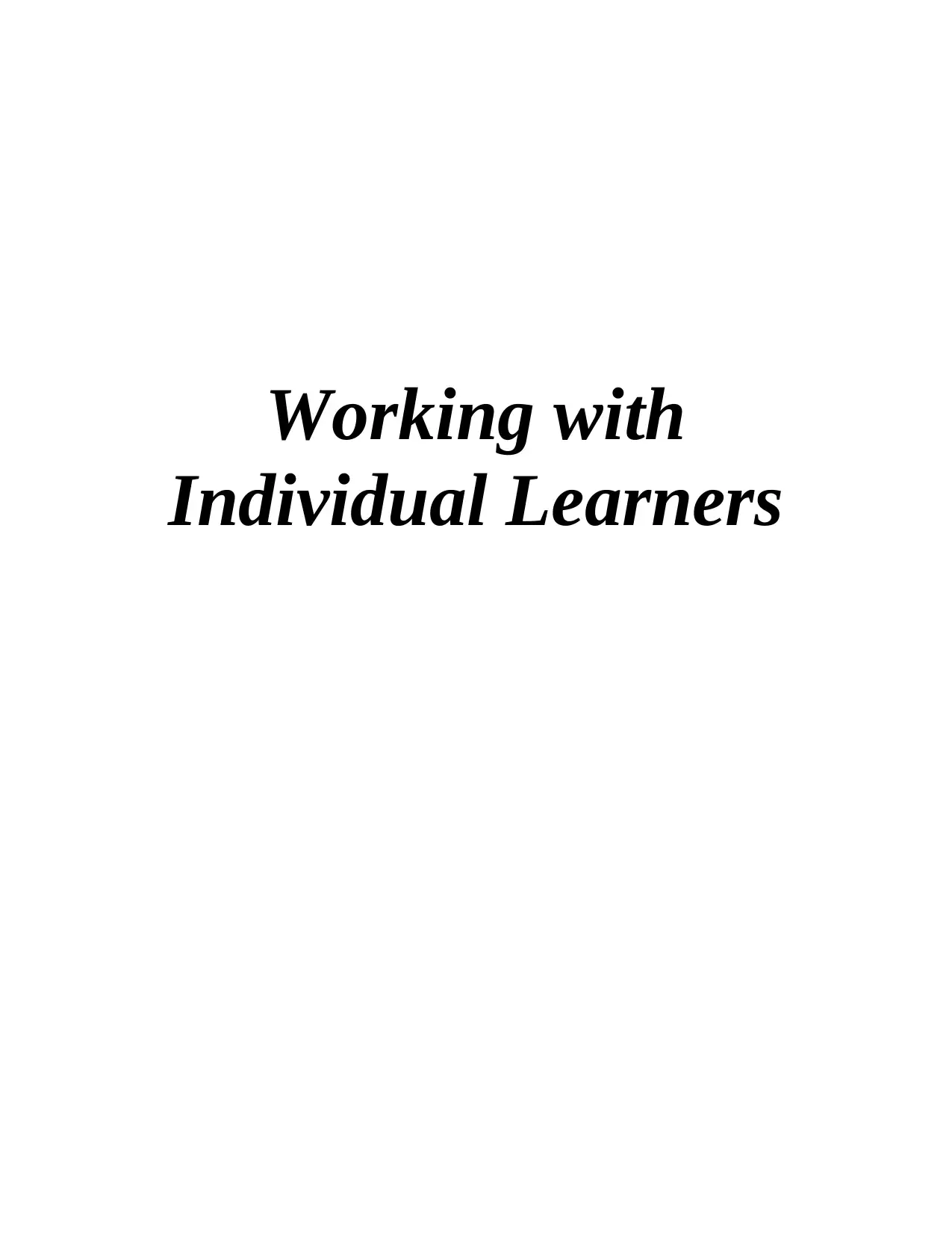
Working with
Individual Learners
Individual Learners
Secure Best Marks with AI Grader
Need help grading? Try our AI Grader for instant feedback on your assignments.
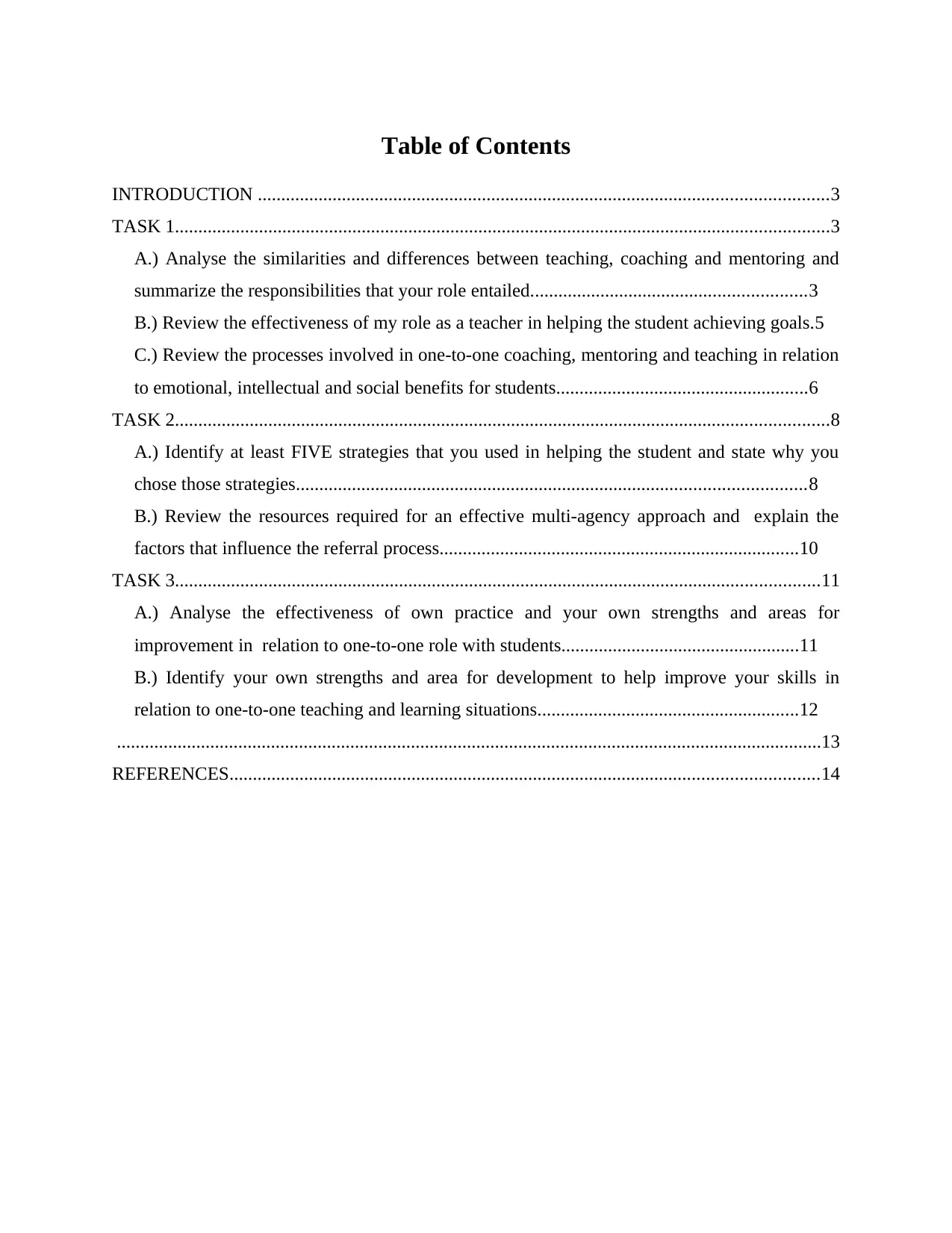
Table of Contents
INTRODUCTION ..........................................................................................................................3
TASK 1............................................................................................................................................3
A.) Analyse the similarities and differences between teaching, coaching and mentoring and
summarize the responsibilities that your role entailed...........................................................3
B.) Review the effectiveness of my role as a teacher in helping the student achieving goals.5
C.) Review the processes involved in one-to-one coaching, mentoring and teaching in relation
to emotional, intellectual and social benefits for students......................................................6
TASK 2............................................................................................................................................8
A.) Identify at least FIVE strategies that you used in helping the student and state why you
chose those strategies.............................................................................................................8
B.) Review the resources required for an effective multi-agency approach and explain the
factors that influence the referral process.............................................................................10
TASK 3..........................................................................................................................................11
A.) Analyse the effectiveness of own practice and your own strengths and areas for
improvement in relation to one-to-one role with students...................................................11
B.) Identify your own strengths and area for development to help improve your skills in
relation to one-to-one teaching and learning situations........................................................12
.......................................................................................................................................................13
REFERENCES..............................................................................................................................14
INTRODUCTION ..........................................................................................................................3
TASK 1............................................................................................................................................3
A.) Analyse the similarities and differences between teaching, coaching and mentoring and
summarize the responsibilities that your role entailed...........................................................3
B.) Review the effectiveness of my role as a teacher in helping the student achieving goals.5
C.) Review the processes involved in one-to-one coaching, mentoring and teaching in relation
to emotional, intellectual and social benefits for students......................................................6
TASK 2............................................................................................................................................8
A.) Identify at least FIVE strategies that you used in helping the student and state why you
chose those strategies.............................................................................................................8
B.) Review the resources required for an effective multi-agency approach and explain the
factors that influence the referral process.............................................................................10
TASK 3..........................................................................................................................................11
A.) Analyse the effectiveness of own practice and your own strengths and areas for
improvement in relation to one-to-one role with students...................................................11
B.) Identify your own strengths and area for development to help improve your skills in
relation to one-to-one teaching and learning situations........................................................12
.......................................................................................................................................................13
REFERENCES..............................................................................................................................14
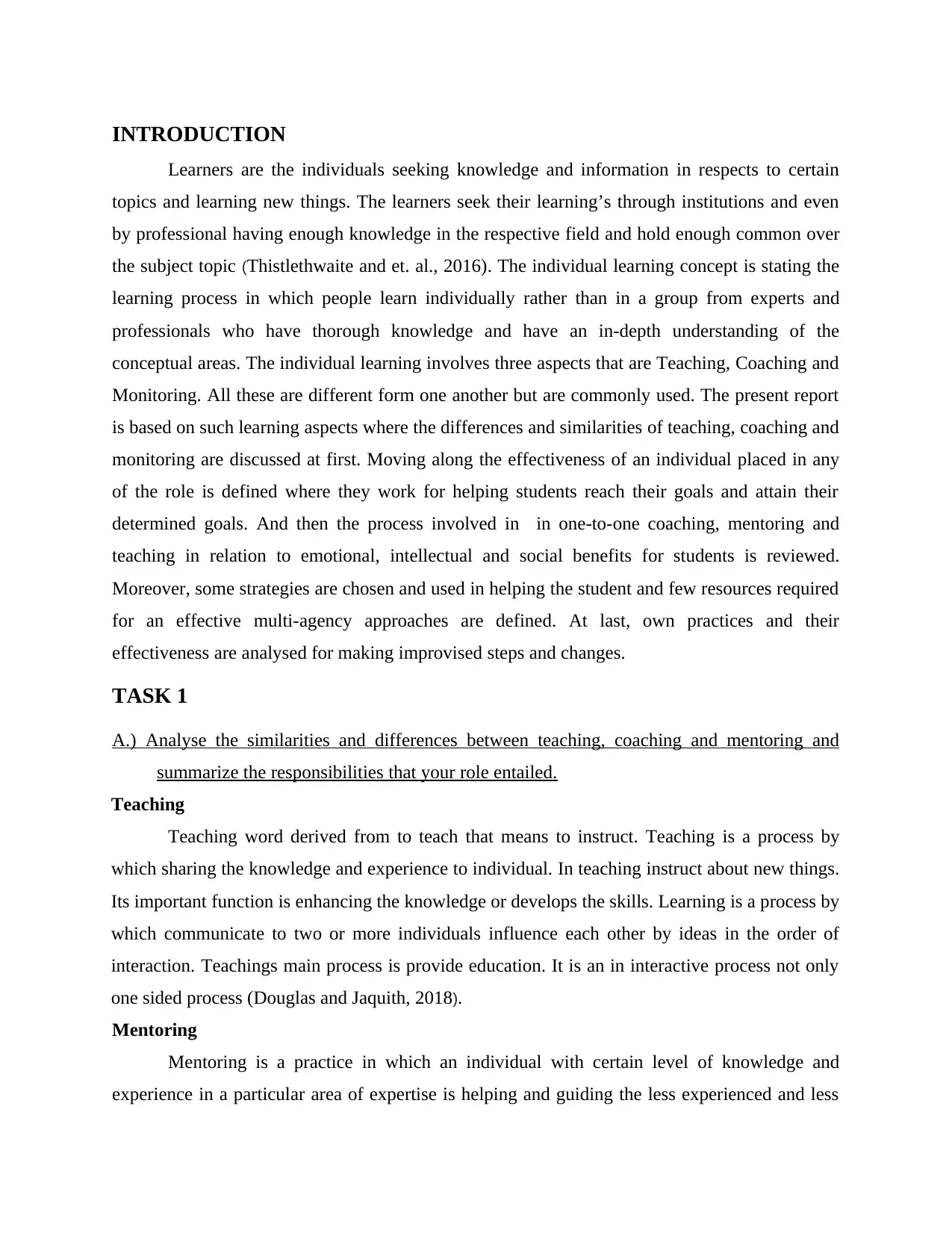
INTRODUCTION
Learners are the individuals seeking knowledge and information in respects to certain
topics and learning new things. The learners seek their learning’s through institutions and even
by professional having enough knowledge in the respective field and hold enough common over
the subject topic (Thistlethwaite and et. al., 2016). The individual learning concept is stating the
learning process in which people learn individually rather than in a group from experts and
professionals who have thorough knowledge and have an in-depth understanding of the
conceptual areas. The individual learning involves three aspects that are Teaching, Coaching and
Monitoring. All these are different form one another but are commonly used. The present report
is based on such learning aspects where the differences and similarities of teaching, coaching and
monitoring are discussed at first. Moving along the effectiveness of an individual placed in any
of the role is defined where they work for helping students reach their goals and attain their
determined goals. And then the process involved in in one-to-one coaching, mentoring and
teaching in relation to emotional, intellectual and social benefits for students is reviewed.
Moreover, some strategies are chosen and used in helping the student and few resources required
for an effective multi-agency approaches are defined. At last, own practices and their
effectiveness are analysed for making improvised steps and changes.
TASK 1
A.) Analyse the similarities and differences between teaching, coaching and mentoring and
summarize the responsibilities that your role entailed.
Teaching
Teaching word derived from to teach that means to instruct. Teaching is a process by
which sharing the knowledge and experience to individual. In teaching instruct about new things.
Its important function is enhancing the knowledge or develops the skills. Learning is a process by
which communicate to two or more individuals influence each other by ideas in the order of
interaction. Teachings main process is provide education. It is an in interactive process not only
one sided process (Douglas and Jaquith, 2018).
Mentoring
Mentoring is a practice in which an individual with certain level of knowledge and
experience in a particular area of expertise is helping and guiding the less experienced and less
Learners are the individuals seeking knowledge and information in respects to certain
topics and learning new things. The learners seek their learning’s through institutions and even
by professional having enough knowledge in the respective field and hold enough common over
the subject topic (Thistlethwaite and et. al., 2016). The individual learning concept is stating the
learning process in which people learn individually rather than in a group from experts and
professionals who have thorough knowledge and have an in-depth understanding of the
conceptual areas. The individual learning involves three aspects that are Teaching, Coaching and
Monitoring. All these are different form one another but are commonly used. The present report
is based on such learning aspects where the differences and similarities of teaching, coaching and
monitoring are discussed at first. Moving along the effectiveness of an individual placed in any
of the role is defined where they work for helping students reach their goals and attain their
determined goals. And then the process involved in in one-to-one coaching, mentoring and
teaching in relation to emotional, intellectual and social benefits for students is reviewed.
Moreover, some strategies are chosen and used in helping the student and few resources required
for an effective multi-agency approaches are defined. At last, own practices and their
effectiveness are analysed for making improvised steps and changes.
TASK 1
A.) Analyse the similarities and differences between teaching, coaching and mentoring and
summarize the responsibilities that your role entailed.
Teaching
Teaching word derived from to teach that means to instruct. Teaching is a process by
which sharing the knowledge and experience to individual. In teaching instruct about new things.
Its important function is enhancing the knowledge or develops the skills. Learning is a process by
which communicate to two or more individuals influence each other by ideas in the order of
interaction. Teachings main process is provide education. It is an in interactive process not only
one sided process (Douglas and Jaquith, 2018).
Mentoring
Mentoring is a practice in which an individual with certain level of knowledge and
experience in a particular area of expertise is helping and guiding the less experienced and less
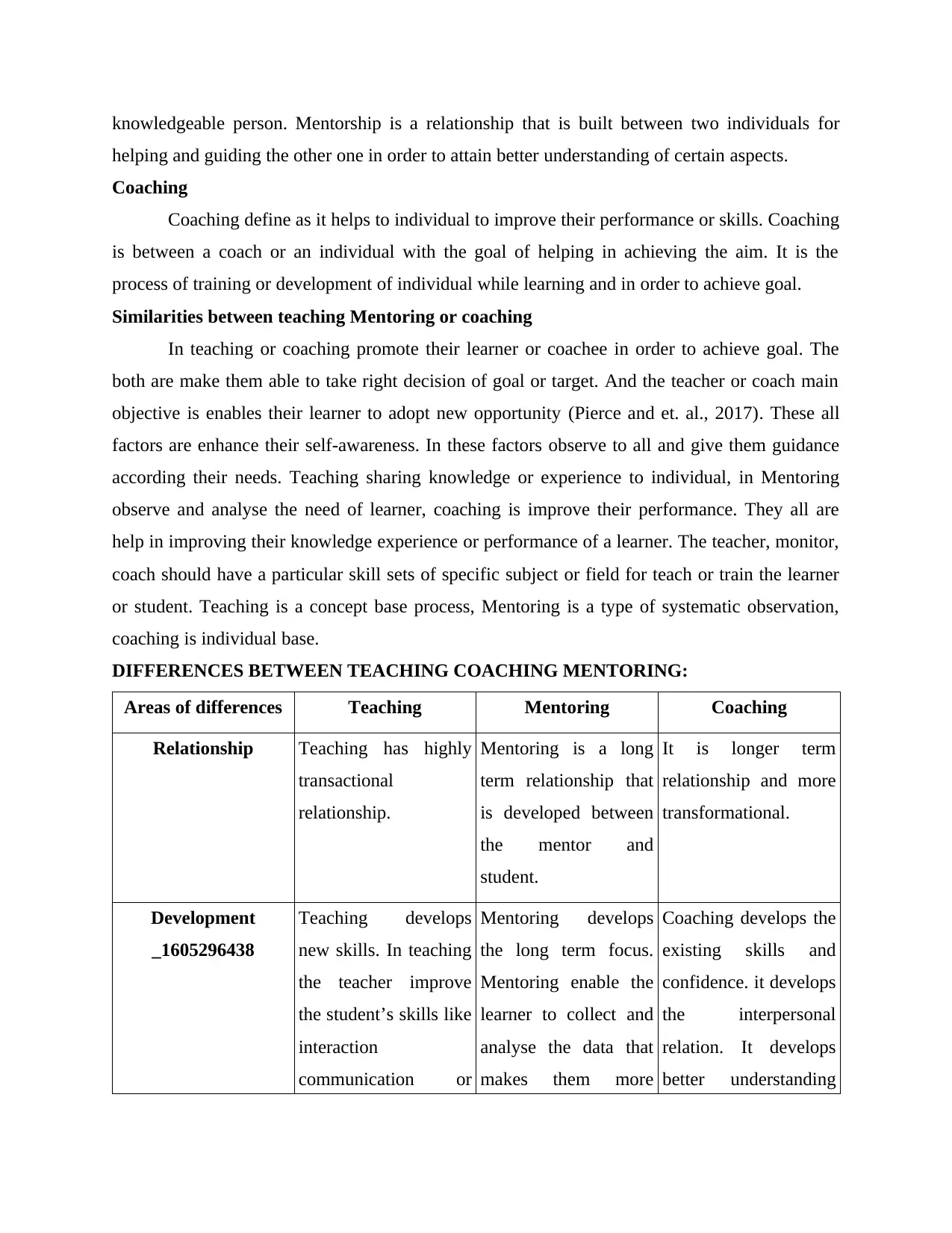
knowledgeable person. Mentorship is a relationship that is built between two individuals for
helping and guiding the other one in order to attain better understanding of certain aspects.
Coaching
Coaching define as it helps to individual to improve their performance or skills. Coaching
is between a coach or an individual with the goal of helping in achieving the aim. It is the
process of training or development of individual while learning and in order to achieve goal.
Similarities between teaching Mentoring or coaching
In teaching or coaching promote their learner or coachee in order to achieve goal. The
both are make them able to take right decision of goal or target. And the teacher or coach main
objective is enables their learner to adopt new opportunity (Pierce and et. al., 2017). These all
factors are enhance their self-awareness. In these factors observe to all and give them guidance
according their needs. Teaching sharing knowledge or experience to individual, in Mentoring
observe and analyse the need of learner, coaching is improve their performance. They all are
help in improving their knowledge experience or performance of a learner. The teacher, monitor,
coach should have a particular skill sets of specific subject or field for teach or train the learner
or student. Teaching is a concept base process, Mentoring is a type of systematic observation,
coaching is individual base.
DIFFERENCES BETWEEN TEACHING COACHING MENTORING:
Areas of differences Teaching Mentoring Coaching
Relationship Teaching has highly
transactional
relationship.
Mentoring is a long
term relationship that
is developed between
the mentor and
student.
It is longer term
relationship and more
transformational.
Development
_1605296438
Teaching develops
new skills. In teaching
the teacher improve
the student’s skills like
interaction
communication or
Mentoring develops
the long term focus.
Mentoring enable the
learner to collect and
analyse the data that
makes them more
Coaching develops the
existing skills and
confidence. it develops
the interpersonal
relation. It develops
better understanding
helping and guiding the other one in order to attain better understanding of certain aspects.
Coaching
Coaching define as it helps to individual to improve their performance or skills. Coaching
is between a coach or an individual with the goal of helping in achieving the aim. It is the
process of training or development of individual while learning and in order to achieve goal.
Similarities between teaching Mentoring or coaching
In teaching or coaching promote their learner or coachee in order to achieve goal. The
both are make them able to take right decision of goal or target. And the teacher or coach main
objective is enables their learner to adopt new opportunity (Pierce and et. al., 2017). These all
factors are enhance their self-awareness. In these factors observe to all and give them guidance
according their needs. Teaching sharing knowledge or experience to individual, in Mentoring
observe and analyse the need of learner, coaching is improve their performance. They all are
help in improving their knowledge experience or performance of a learner. The teacher, monitor,
coach should have a particular skill sets of specific subject or field for teach or train the learner
or student. Teaching is a concept base process, Mentoring is a type of systematic observation,
coaching is individual base.
DIFFERENCES BETWEEN TEACHING COACHING MENTORING:
Areas of differences Teaching Mentoring Coaching
Relationship Teaching has highly
transactional
relationship.
Mentoring is a long
term relationship that
is developed between
the mentor and
student.
It is longer term
relationship and more
transformational.
Development
_1605296438
Teaching develops
new skills. In teaching
the teacher improve
the student’s skills like
interaction
communication or
Mentoring develops
the long term focus.
Mentoring enable the
learner to collect and
analyse the data that
makes them more
Coaching develops the
existing skills and
confidence. it develops
the interpersonal
relation. It develops
better understanding
Secure Best Marks with AI Grader
Need help grading? Try our AI Grader for instant feedback on your assignments.
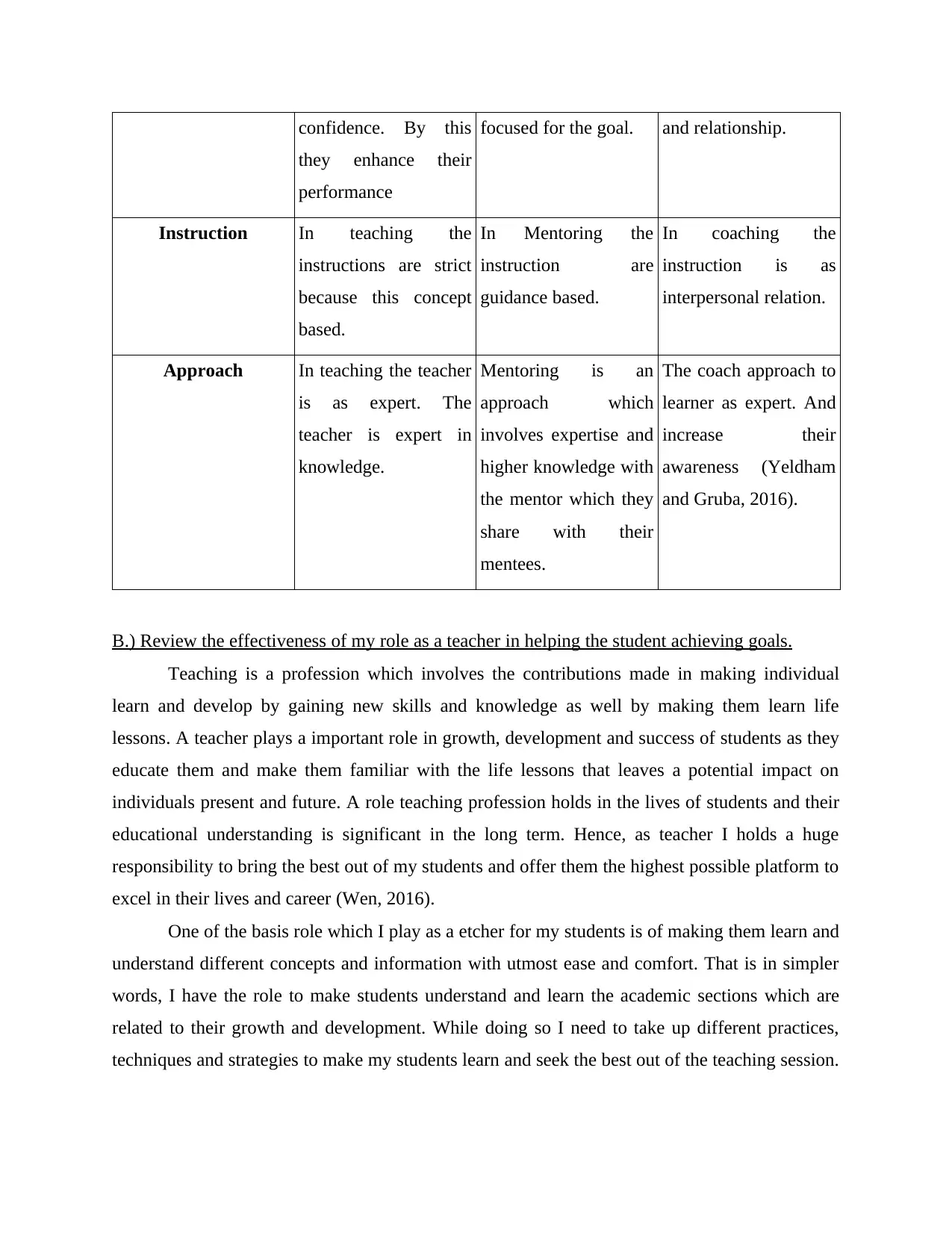
confidence. By this
they enhance their
performance
focused for the goal. and relationship.
Instruction In teaching the
instructions are strict
because this concept
based.
In Mentoring the
instruction are
guidance based.
In coaching the
instruction is as
interpersonal relation.
Approach In teaching the teacher
is as expert. The
teacher is expert in
knowledge.
Mentoring is an
approach which
involves expertise and
higher knowledge with
the mentor which they
share with their
mentees.
The coach approach to
learner as expert. And
increase their
awareness (Yeldham
and Gruba, 2016).
B.) Review the effectiveness of my role as a teacher in helping the student achieving goals.
Teaching is a profession which involves the contributions made in making individual
learn and develop by gaining new skills and knowledge as well by making them learn life
lessons. A teacher plays a important role in growth, development and success of students as they
educate them and make them familiar with the life lessons that leaves a potential impact on
individuals present and future. A role teaching profession holds in the lives of students and their
educational understanding is significant in the long term. Hence, as teacher I holds a huge
responsibility to bring the best out of my students and offer them the highest possible platform to
excel in their lives and career (Wen, 2016).
One of the basis role which I play as a etcher for my students is of making them learn and
understand different concepts and information with utmost ease and comfort. That is in simpler
words, I have the role to make students understand and learn the academic sections which are
related to their growth and development. While doing so I need to take up different practices,
techniques and strategies to make my students learn and seek the best out of the teaching session.
they enhance their
performance
focused for the goal. and relationship.
Instruction In teaching the
instructions are strict
because this concept
based.
In Mentoring the
instruction are
guidance based.
In coaching the
instruction is as
interpersonal relation.
Approach In teaching the teacher
is as expert. The
teacher is expert in
knowledge.
Mentoring is an
approach which
involves expertise and
higher knowledge with
the mentor which they
share with their
mentees.
The coach approach to
learner as expert. And
increase their
awareness (Yeldham
and Gruba, 2016).
B.) Review the effectiveness of my role as a teacher in helping the student achieving goals.
Teaching is a profession which involves the contributions made in making individual
learn and develop by gaining new skills and knowledge as well by making them learn life
lessons. A teacher plays a important role in growth, development and success of students as they
educate them and make them familiar with the life lessons that leaves a potential impact on
individuals present and future. A role teaching profession holds in the lives of students and their
educational understanding is significant in the long term. Hence, as teacher I holds a huge
responsibility to bring the best out of my students and offer them the highest possible platform to
excel in their lives and career (Wen, 2016).
One of the basis role which I play as a etcher for my students is of making them learn and
understand different concepts and information with utmost ease and comfort. That is in simpler
words, I have the role to make students understand and learn the academic sections which are
related to their growth and development. While doing so I need to take up different practices,
techniques and strategies to make my students learn and seek the best out of the teaching session.
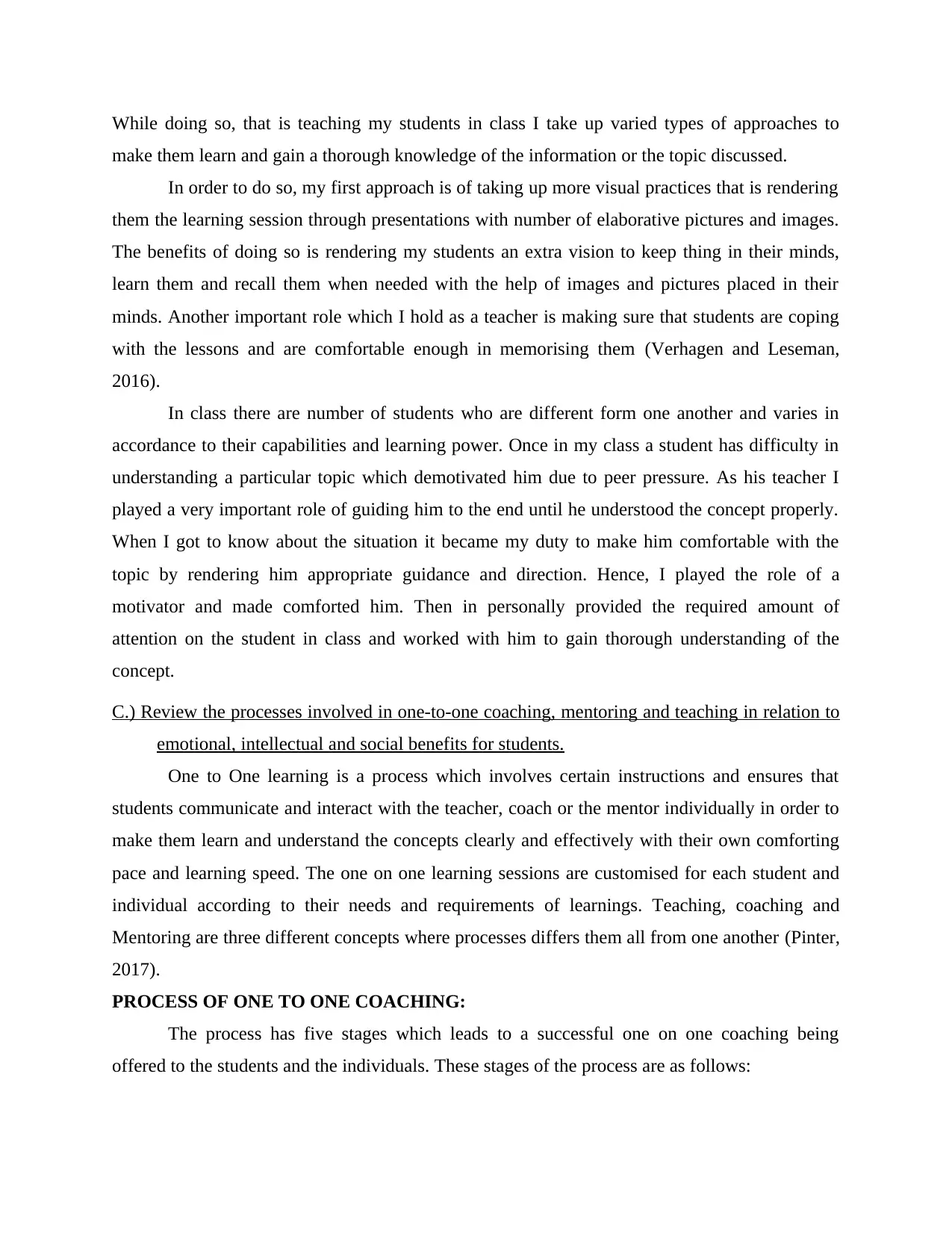
While doing so, that is teaching my students in class I take up varied types of approaches to
make them learn and gain a thorough knowledge of the information or the topic discussed.
In order to do so, my first approach is of taking up more visual practices that is rendering
them the learning session through presentations with number of elaborative pictures and images.
The benefits of doing so is rendering my students an extra vision to keep thing in their minds,
learn them and recall them when needed with the help of images and pictures placed in their
minds. Another important role which I hold as a teacher is making sure that students are coping
with the lessons and are comfortable enough in memorising them (Verhagen and Leseman,
2016).
In class there are number of students who are different form one another and varies in
accordance to their capabilities and learning power. Once in my class a student has difficulty in
understanding a particular topic which demotivated him due to peer pressure. As his teacher I
played a very important role of guiding him to the end until he understood the concept properly.
When I got to know about the situation it became my duty to make him comfortable with the
topic by rendering him appropriate guidance and direction. Hence, I played the role of a
motivator and made comforted him. Then in personally provided the required amount of
attention on the student in class and worked with him to gain thorough understanding of the
concept.
C.) Review the processes involved in one-to-one coaching, mentoring and teaching in relation to
emotional, intellectual and social benefits for students.
One to One learning is a process which involves certain instructions and ensures that
students communicate and interact with the teacher, coach or the mentor individually in order to
make them learn and understand the concepts clearly and effectively with their own comforting
pace and learning speed. The one on one learning sessions are customised for each student and
individual according to their needs and requirements of learnings. Teaching, coaching and
Mentoring are three different concepts where processes differs them all from one another (Pinter,
2017).
PROCESS OF ONE TO ONE COACHING:
The process has five stages which leads to a successful one on one coaching being
offered to the students and the individuals. These stages of the process are as follows:
make them learn and gain a thorough knowledge of the information or the topic discussed.
In order to do so, my first approach is of taking up more visual practices that is rendering
them the learning session through presentations with number of elaborative pictures and images.
The benefits of doing so is rendering my students an extra vision to keep thing in their minds,
learn them and recall them when needed with the help of images and pictures placed in their
minds. Another important role which I hold as a teacher is making sure that students are coping
with the lessons and are comfortable enough in memorising them (Verhagen and Leseman,
2016).
In class there are number of students who are different form one another and varies in
accordance to their capabilities and learning power. Once in my class a student has difficulty in
understanding a particular topic which demotivated him due to peer pressure. As his teacher I
played a very important role of guiding him to the end until he understood the concept properly.
When I got to know about the situation it became my duty to make him comfortable with the
topic by rendering him appropriate guidance and direction. Hence, I played the role of a
motivator and made comforted him. Then in personally provided the required amount of
attention on the student in class and worked with him to gain thorough understanding of the
concept.
C.) Review the processes involved in one-to-one coaching, mentoring and teaching in relation to
emotional, intellectual and social benefits for students.
One to One learning is a process which involves certain instructions and ensures that
students communicate and interact with the teacher, coach or the mentor individually in order to
make them learn and understand the concepts clearly and effectively with their own comforting
pace and learning speed. The one on one learning sessions are customised for each student and
individual according to their needs and requirements of learnings. Teaching, coaching and
Mentoring are three different concepts where processes differs them all from one another (Pinter,
2017).
PROCESS OF ONE TO ONE COACHING:
The process has five stages which leads to a successful one on one coaching being
offered to the students and the individuals. These stages of the process are as follows:
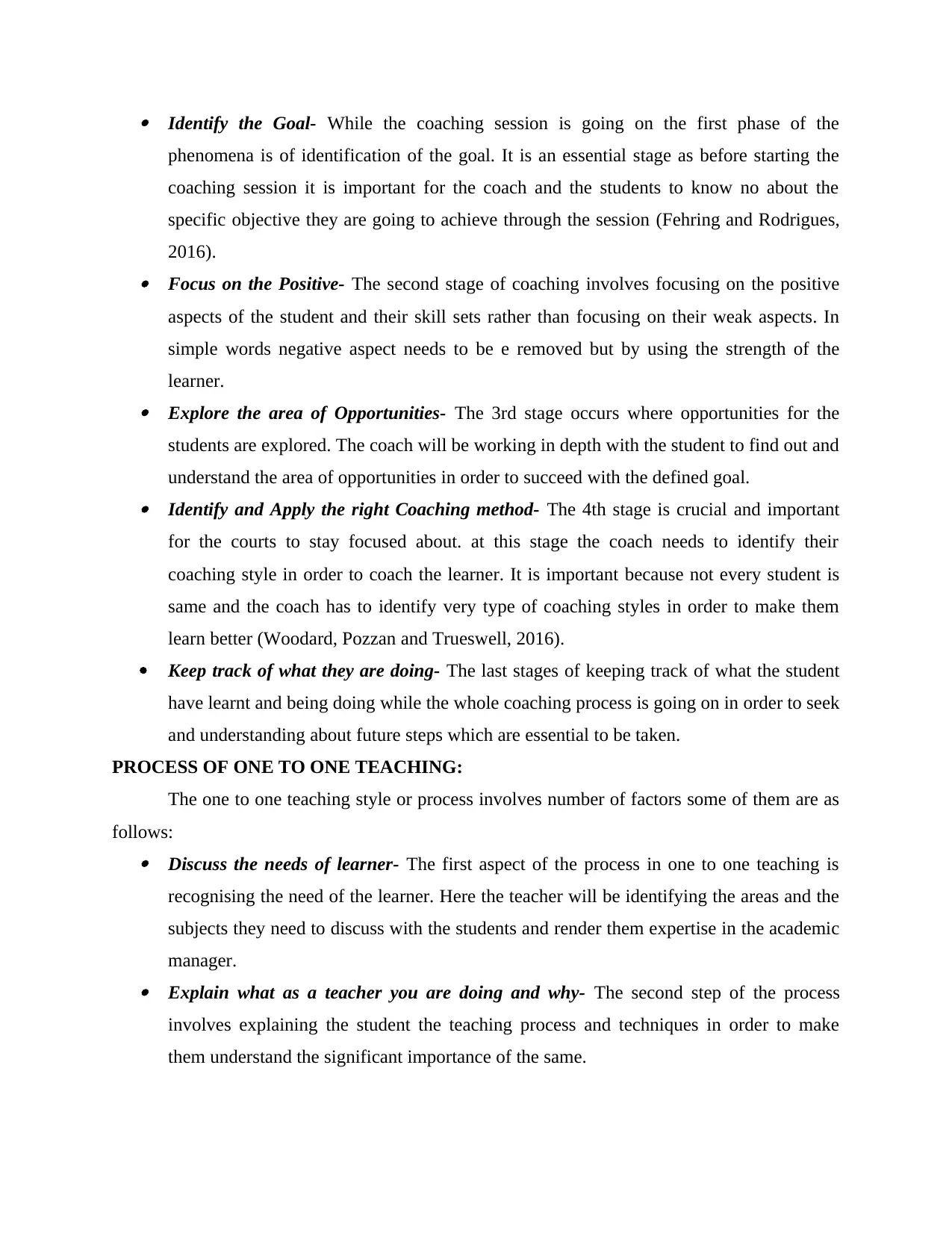
Identify the Goal- While the coaching session is going on the first phase of the
phenomena is of identification of the goal. It is an essential stage as before starting the
coaching session it is important for the coach and the students to know no about the
specific objective they are going to achieve through the session (Fehring and Rodrigues,
2016). Focus on the Positive- The second stage of coaching involves focusing on the positive
aspects of the student and their skill sets rather than focusing on their weak aspects. In
simple words negative aspect needs to be e removed but by using the strength of the
learner. Explore the area of Opportunities- The 3rd stage occurs where opportunities for the
students are explored. The coach will be working in depth with the student to find out and
understand the area of opportunities in order to succeed with the defined goal. Identify and Apply the right Coaching method- The 4th stage is crucial and important
for the courts to stay focused about. at this stage the coach needs to identify their
coaching style in order to coach the learner. It is important because not every student is
same and the coach has to identify very type of coaching styles in order to make them
learn better (Woodard, Pozzan and Trueswell, 2016).
Keep track of what they are doing- The last stages of keeping track of what the student
have learnt and being doing while the whole coaching process is going on in order to seek
and understanding about future steps which are essential to be taken.
PROCESS OF ONE TO ONE TEACHING:
The one to one teaching style or process involves number of factors some of them are as
follows: Discuss the needs of learner- The first aspect of the process in one to one teaching is
recognising the need of the learner. Here the teacher will be identifying the areas and the
subjects they need to discuss with the students and render them expertise in the academic
manager. Explain what as a teacher you are doing and why- The second step of the process
involves explaining the student the teaching process and techniques in order to make
them understand the significant importance of the same.
phenomena is of identification of the goal. It is an essential stage as before starting the
coaching session it is important for the coach and the students to know no about the
specific objective they are going to achieve through the session (Fehring and Rodrigues,
2016). Focus on the Positive- The second stage of coaching involves focusing on the positive
aspects of the student and their skill sets rather than focusing on their weak aspects. In
simple words negative aspect needs to be e removed but by using the strength of the
learner. Explore the area of Opportunities- The 3rd stage occurs where opportunities for the
students are explored. The coach will be working in depth with the student to find out and
understand the area of opportunities in order to succeed with the defined goal. Identify and Apply the right Coaching method- The 4th stage is crucial and important
for the courts to stay focused about. at this stage the coach needs to identify their
coaching style in order to coach the learner. It is important because not every student is
same and the coach has to identify very type of coaching styles in order to make them
learn better (Woodard, Pozzan and Trueswell, 2016).
Keep track of what they are doing- The last stages of keeping track of what the student
have learnt and being doing while the whole coaching process is going on in order to seek
and understanding about future steps which are essential to be taken.
PROCESS OF ONE TO ONE TEACHING:
The one to one teaching style or process involves number of factors some of them are as
follows: Discuss the needs of learner- The first aspect of the process in one to one teaching is
recognising the need of the learner. Here the teacher will be identifying the areas and the
subjects they need to discuss with the students and render them expertise in the academic
manager. Explain what as a teacher you are doing and why- The second step of the process
involves explaining the student the teaching process and techniques in order to make
them understand the significant importance of the same.
Paraphrase This Document
Need a fresh take? Get an instant paraphrase of this document with our AI Paraphraser
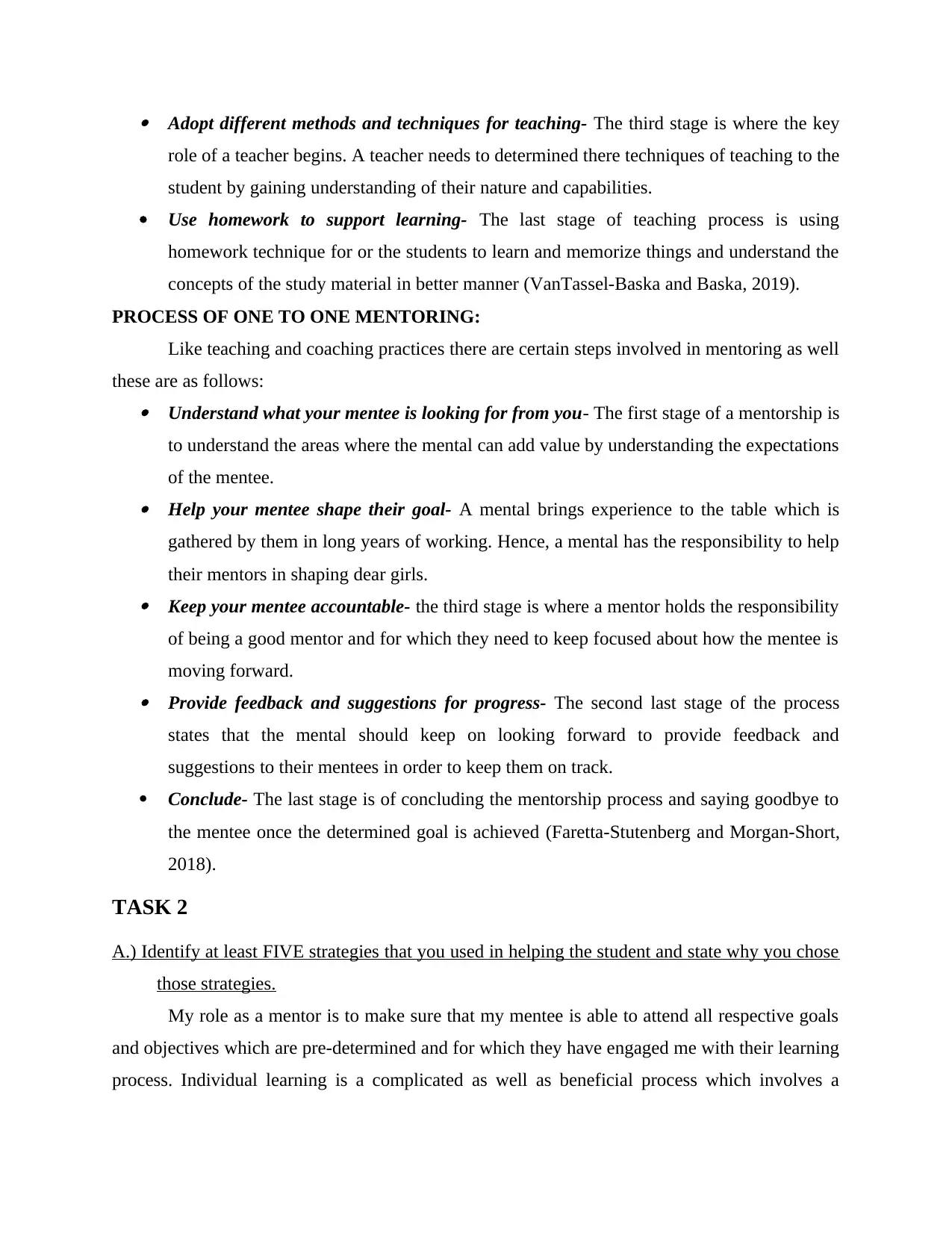
Adopt different methods and techniques for teaching- The third stage is where the key
role of a teacher begins. A teacher needs to determined there techniques of teaching to the
student by gaining understanding of their nature and capabilities.
Use homework to support learning- The last stage of teaching process is using
homework technique for or the students to learn and memorize things and understand the
concepts of the study material in better manner (VanTassel-Baska and Baska, 2019).
PROCESS OF ONE TO ONE MENTORING:
Like teaching and coaching practices there are certain steps involved in mentoring as well
these are as follows: Understand what your mentee is looking for from you- The first stage of a mentorship is
to understand the areas where the mental can add value by understanding the expectations
of the mentee. Help your mentee shape their goal- A mental brings experience to the table which is
gathered by them in long years of working. Hence, a mental has the responsibility to help
their mentors in shaping dear girls. Keep your mentee accountable- the third stage is where a mentor holds the responsibility
of being a good mentor and for which they need to keep focused about how the mentee is
moving forward. Provide feedback and suggestions for progress- The second last stage of the process
states that the mental should keep on looking forward to provide feedback and
suggestions to their mentees in order to keep them on track.
Conclude- The last stage is of concluding the mentorship process and saying goodbye to
the mentee once the determined goal is achieved (Faretta-Stutenberg and Morgan-Short,
2018).
TASK 2
A.) Identify at least FIVE strategies that you used in helping the student and state why you chose
those strategies.
My role as a mentor is to make sure that my mentee is able to attend all respective goals
and objectives which are pre-determined and for which they have engaged me with their learning
process. Individual learning is a complicated as well as beneficial process which involves a
role of a teacher begins. A teacher needs to determined there techniques of teaching to the
student by gaining understanding of their nature and capabilities.
Use homework to support learning- The last stage of teaching process is using
homework technique for or the students to learn and memorize things and understand the
concepts of the study material in better manner (VanTassel-Baska and Baska, 2019).
PROCESS OF ONE TO ONE MENTORING:
Like teaching and coaching practices there are certain steps involved in mentoring as well
these are as follows: Understand what your mentee is looking for from you- The first stage of a mentorship is
to understand the areas where the mental can add value by understanding the expectations
of the mentee. Help your mentee shape their goal- A mental brings experience to the table which is
gathered by them in long years of working. Hence, a mental has the responsibility to help
their mentors in shaping dear girls. Keep your mentee accountable- the third stage is where a mentor holds the responsibility
of being a good mentor and for which they need to keep focused about how the mentee is
moving forward. Provide feedback and suggestions for progress- The second last stage of the process
states that the mental should keep on looking forward to provide feedback and
suggestions to their mentees in order to keep them on track.
Conclude- The last stage is of concluding the mentorship process and saying goodbye to
the mentee once the determined goal is achieved (Faretta-Stutenberg and Morgan-Short,
2018).
TASK 2
A.) Identify at least FIVE strategies that you used in helping the student and state why you chose
those strategies.
My role as a mentor is to make sure that my mentee is able to attend all respective goals
and objectives which are pre-determined and for which they have engaged me with their learning
process. Individual learning is a complicated as well as beneficial process which involves a
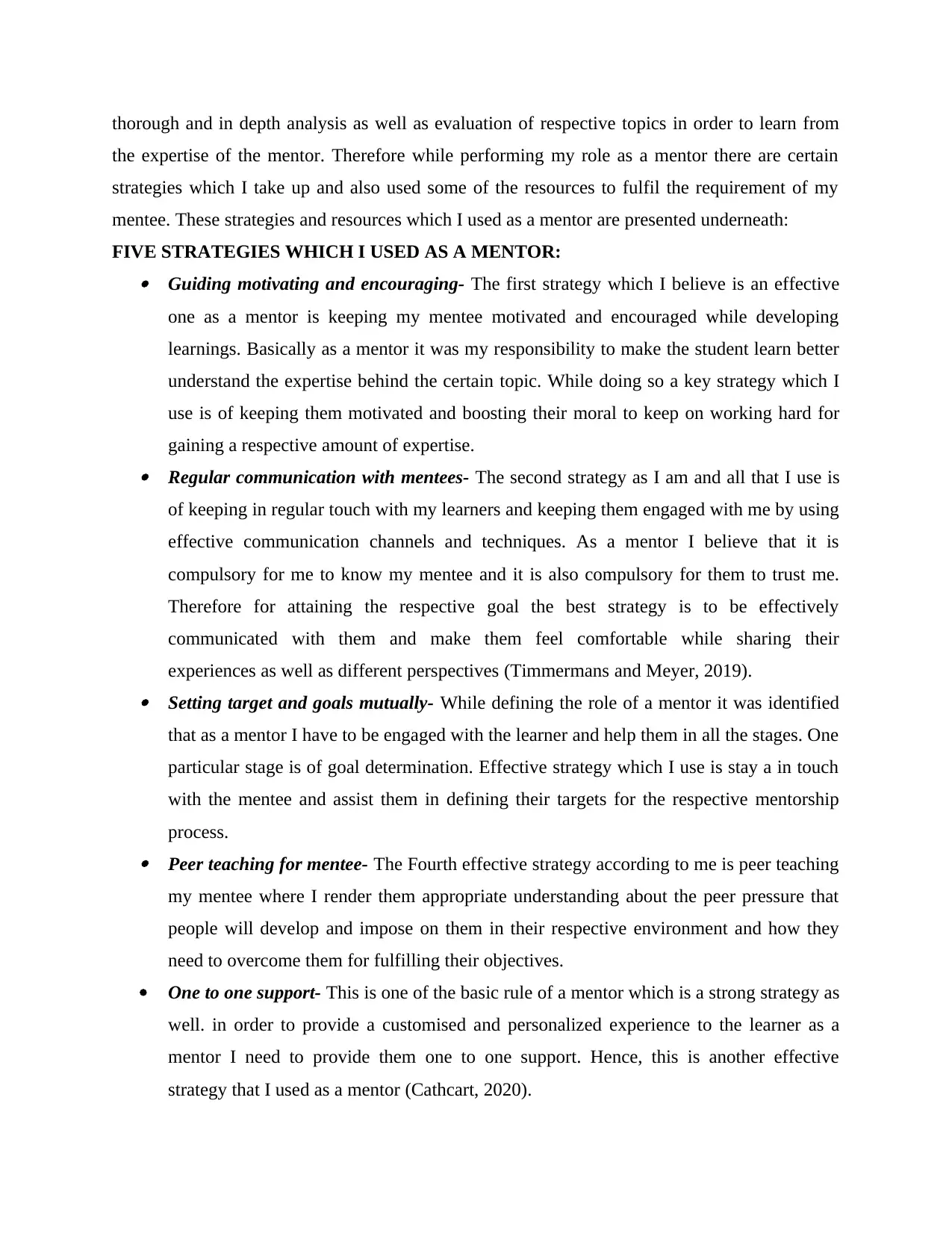
thorough and in depth analysis as well as evaluation of respective topics in order to learn from
the expertise of the mentor. Therefore while performing my role as a mentor there are certain
strategies which I take up and also used some of the resources to fulfil the requirement of my
mentee. These strategies and resources which I used as a mentor are presented underneath:
FIVE STRATEGIES WHICH I USED AS A MENTOR: Guiding motivating and encouraging- The first strategy which I believe is an effective
one as a mentor is keeping my mentee motivated and encouraged while developing
learnings. Basically as a mentor it was my responsibility to make the student learn better
understand the expertise behind the certain topic. While doing so a key strategy which I
use is of keeping them motivated and boosting their moral to keep on working hard for
gaining a respective amount of expertise. Regular communication with mentees- The second strategy as I am and all that I use is
of keeping in regular touch with my learners and keeping them engaged with me by using
effective communication channels and techniques. As a mentor I believe that it is
compulsory for me to know my mentee and it is also compulsory for them to trust me.
Therefore for attaining the respective goal the best strategy is to be effectively
communicated with them and make them feel comfortable while sharing their
experiences as well as different perspectives (Timmermans and Meyer, 2019). Setting target and goals mutually- While defining the role of a mentor it was identified
that as a mentor I have to be engaged with the learner and help them in all the stages. One
particular stage is of goal determination. Effective strategy which I use is stay a in touch
with the mentee and assist them in defining their targets for the respective mentorship
process. Peer teaching for mentee- The Fourth effective strategy according to me is peer teaching
my mentee where I render them appropriate understanding about the peer pressure that
people will develop and impose on them in their respective environment and how they
need to overcome them for fulfilling their objectives.
One to one support- This is one of the basic rule of a mentor which is a strong strategy as
well. in order to provide a customised and personalized experience to the learner as a
mentor I need to provide them one to one support. Hence, this is another effective
strategy that I used as a mentor (Cathcart, 2020).
the expertise of the mentor. Therefore while performing my role as a mentor there are certain
strategies which I take up and also used some of the resources to fulfil the requirement of my
mentee. These strategies and resources which I used as a mentor are presented underneath:
FIVE STRATEGIES WHICH I USED AS A MENTOR: Guiding motivating and encouraging- The first strategy which I believe is an effective
one as a mentor is keeping my mentee motivated and encouraged while developing
learnings. Basically as a mentor it was my responsibility to make the student learn better
understand the expertise behind the certain topic. While doing so a key strategy which I
use is of keeping them motivated and boosting their moral to keep on working hard for
gaining a respective amount of expertise. Regular communication with mentees- The second strategy as I am and all that I use is
of keeping in regular touch with my learners and keeping them engaged with me by using
effective communication channels and techniques. As a mentor I believe that it is
compulsory for me to know my mentee and it is also compulsory for them to trust me.
Therefore for attaining the respective goal the best strategy is to be effectively
communicated with them and make them feel comfortable while sharing their
experiences as well as different perspectives (Timmermans and Meyer, 2019). Setting target and goals mutually- While defining the role of a mentor it was identified
that as a mentor I have to be engaged with the learner and help them in all the stages. One
particular stage is of goal determination. Effective strategy which I use is stay a in touch
with the mentee and assist them in defining their targets for the respective mentorship
process. Peer teaching for mentee- The Fourth effective strategy according to me is peer teaching
my mentee where I render them appropriate understanding about the peer pressure that
people will develop and impose on them in their respective environment and how they
need to overcome them for fulfilling their objectives.
One to one support- This is one of the basic rule of a mentor which is a strong strategy as
well. in order to provide a customised and personalized experience to the learner as a
mentor I need to provide them one to one support. Hence, this is another effective
strategy that I used as a mentor (Cathcart, 2020).
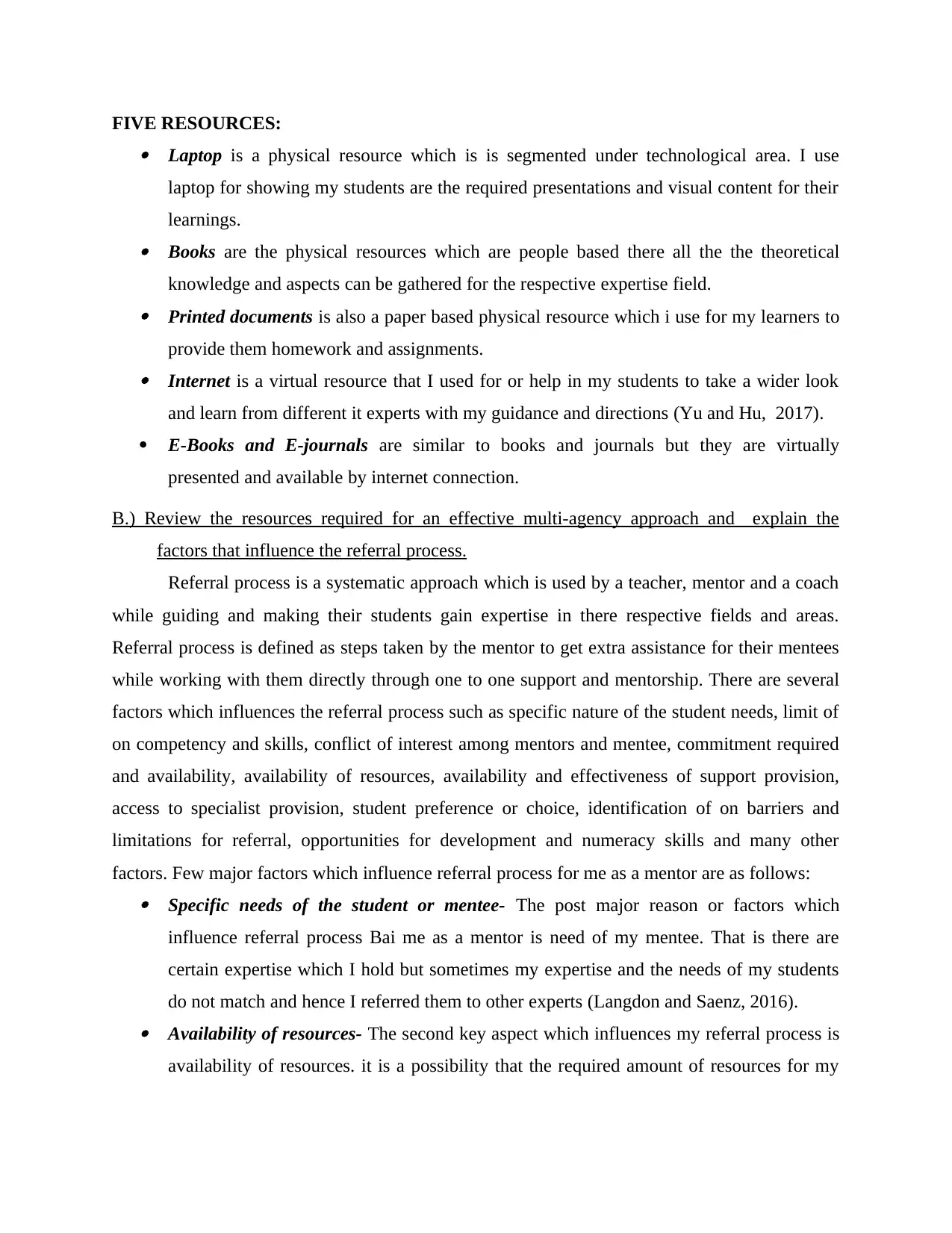
FIVE RESOURCES: Laptop is a physical resource which is is segmented under technological area. I use
laptop for showing my students are the required presentations and visual content for their
learnings. Books are the physical resources which are people based there all the the theoretical
knowledge and aspects can be gathered for the respective expertise field. Printed documents is also a paper based physical resource which i use for my learners to
provide them homework and assignments. Internet is a virtual resource that I used for or help in my students to take a wider look
and learn from different it experts with my guidance and directions (Yu and Hu, 2017).
E-Books and E-journals are similar to books and journals but they are virtually
presented and available by internet connection.
B.) Review the resources required for an effective multi-agency approach and explain the
factors that influence the referral process.
Referral process is a systematic approach which is used by a teacher, mentor and a coach
while guiding and making their students gain expertise in there respective fields and areas.
Referral process is defined as steps taken by the mentor to get extra assistance for their mentees
while working with them directly through one to one support and mentorship. There are several
factors which influences the referral process such as specific nature of the student needs, limit of
on competency and skills, conflict of interest among mentors and mentee, commitment required
and availability, availability of resources, availability and effectiveness of support provision,
access to specialist provision, student preference or choice, identification of on barriers and
limitations for referral, opportunities for development and numeracy skills and many other
factors. Few major factors which influence referral process for me as a mentor are as follows: Specific needs of the student or mentee- The post major reason or factors which
influence referral process Bai me as a mentor is need of my mentee. That is there are
certain expertise which I hold but sometimes my expertise and the needs of my students
do not match and hence I referred them to other experts (Langdon and Saenz, 2016). Availability of resources- The second key aspect which influences my referral process is
availability of resources. it is a possibility that the required amount of resources for my
laptop for showing my students are the required presentations and visual content for their
learnings. Books are the physical resources which are people based there all the the theoretical
knowledge and aspects can be gathered for the respective expertise field. Printed documents is also a paper based physical resource which i use for my learners to
provide them homework and assignments. Internet is a virtual resource that I used for or help in my students to take a wider look
and learn from different it experts with my guidance and directions (Yu and Hu, 2017).
E-Books and E-journals are similar to books and journals but they are virtually
presented and available by internet connection.
B.) Review the resources required for an effective multi-agency approach and explain the
factors that influence the referral process.
Referral process is a systematic approach which is used by a teacher, mentor and a coach
while guiding and making their students gain expertise in there respective fields and areas.
Referral process is defined as steps taken by the mentor to get extra assistance for their mentees
while working with them directly through one to one support and mentorship. There are several
factors which influences the referral process such as specific nature of the student needs, limit of
on competency and skills, conflict of interest among mentors and mentee, commitment required
and availability, availability of resources, availability and effectiveness of support provision,
access to specialist provision, student preference or choice, identification of on barriers and
limitations for referral, opportunities for development and numeracy skills and many other
factors. Few major factors which influence referral process for me as a mentor are as follows: Specific needs of the student or mentee- The post major reason or factors which
influence referral process Bai me as a mentor is need of my mentee. That is there are
certain expertise which I hold but sometimes my expertise and the needs of my students
do not match and hence I referred them to other experts (Langdon and Saenz, 2016). Availability of resources- The second key aspect which influences my referral process is
availability of resources. it is a possibility that the required amount of resources for my
Secure Best Marks with AI Grader
Need help grading? Try our AI Grader for instant feedback on your assignments.
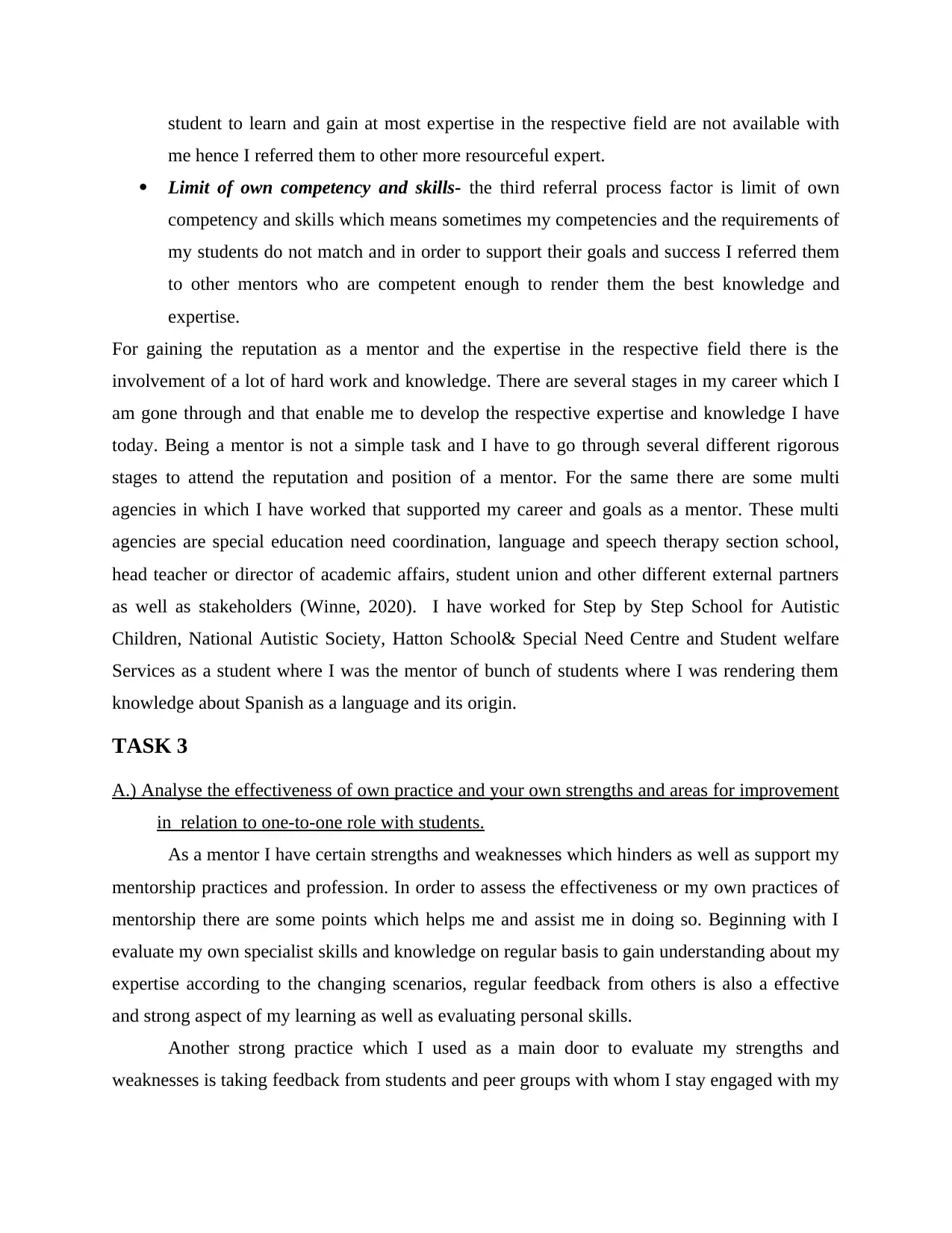
student to learn and gain at most expertise in the respective field are not available with
me hence I referred them to other more resourceful expert.
Limit of own competency and skills- the third referral process factor is limit of own
competency and skills which means sometimes my competencies and the requirements of
my students do not match and in order to support their goals and success I referred them
to other mentors who are competent enough to render them the best knowledge and
expertise.
For gaining the reputation as a mentor and the expertise in the respective field there is the
involvement of a lot of hard work and knowledge. There are several stages in my career which I
am gone through and that enable me to develop the respective expertise and knowledge I have
today. Being a mentor is not a simple task and I have to go through several different rigorous
stages to attend the reputation and position of a mentor. For the same there are some multi
agencies in which I have worked that supported my career and goals as a mentor. These multi
agencies are special education need coordination, language and speech therapy section school,
head teacher or director of academic affairs, student union and other different external partners
as well as stakeholders (Winne, 2020). I have worked for Step by Step School for Autistic
Children, National Autistic Society, Hatton School& Special Need Centre and Student welfare
Services as a student where I was the mentor of bunch of students where I was rendering them
knowledge about Spanish as a language and its origin.
TASK 3
A.) Analyse the effectiveness of own practice and your own strengths and areas for improvement
in relation to one-to-one role with students.
As a mentor I have certain strengths and weaknesses which hinders as well as support my
mentorship practices and profession. In order to assess the effectiveness or my own practices of
mentorship there are some points which helps me and assist me in doing so. Beginning with I
evaluate my own specialist skills and knowledge on regular basis to gain understanding about my
expertise according to the changing scenarios, regular feedback from others is also a effective
and strong aspect of my learning as well as evaluating personal skills.
Another strong practice which I used as a main door to evaluate my strengths and
weaknesses is taking feedback from students and peer groups with whom I stay engaged with my
me hence I referred them to other more resourceful expert.
Limit of own competency and skills- the third referral process factor is limit of own
competency and skills which means sometimes my competencies and the requirements of
my students do not match and in order to support their goals and success I referred them
to other mentors who are competent enough to render them the best knowledge and
expertise.
For gaining the reputation as a mentor and the expertise in the respective field there is the
involvement of a lot of hard work and knowledge. There are several stages in my career which I
am gone through and that enable me to develop the respective expertise and knowledge I have
today. Being a mentor is not a simple task and I have to go through several different rigorous
stages to attend the reputation and position of a mentor. For the same there are some multi
agencies in which I have worked that supported my career and goals as a mentor. These multi
agencies are special education need coordination, language and speech therapy section school,
head teacher or director of academic affairs, student union and other different external partners
as well as stakeholders (Winne, 2020). I have worked for Step by Step School for Autistic
Children, National Autistic Society, Hatton School& Special Need Centre and Student welfare
Services as a student where I was the mentor of bunch of students where I was rendering them
knowledge about Spanish as a language and its origin.
TASK 3
A.) Analyse the effectiveness of own practice and your own strengths and areas for improvement
in relation to one-to-one role with students.
As a mentor I have certain strengths and weaknesses which hinders as well as support my
mentorship practices and profession. In order to assess the effectiveness or my own practices of
mentorship there are some points which helps me and assist me in doing so. Beginning with I
evaluate my own specialist skills and knowledge on regular basis to gain understanding about my
expertise according to the changing scenarios, regular feedback from others is also a effective
and strong aspect of my learning as well as evaluating personal skills.
Another strong practice which I used as a main door to evaluate my strengths and
weaknesses is taking feedback from students and peer groups with whom I stay engaged with my
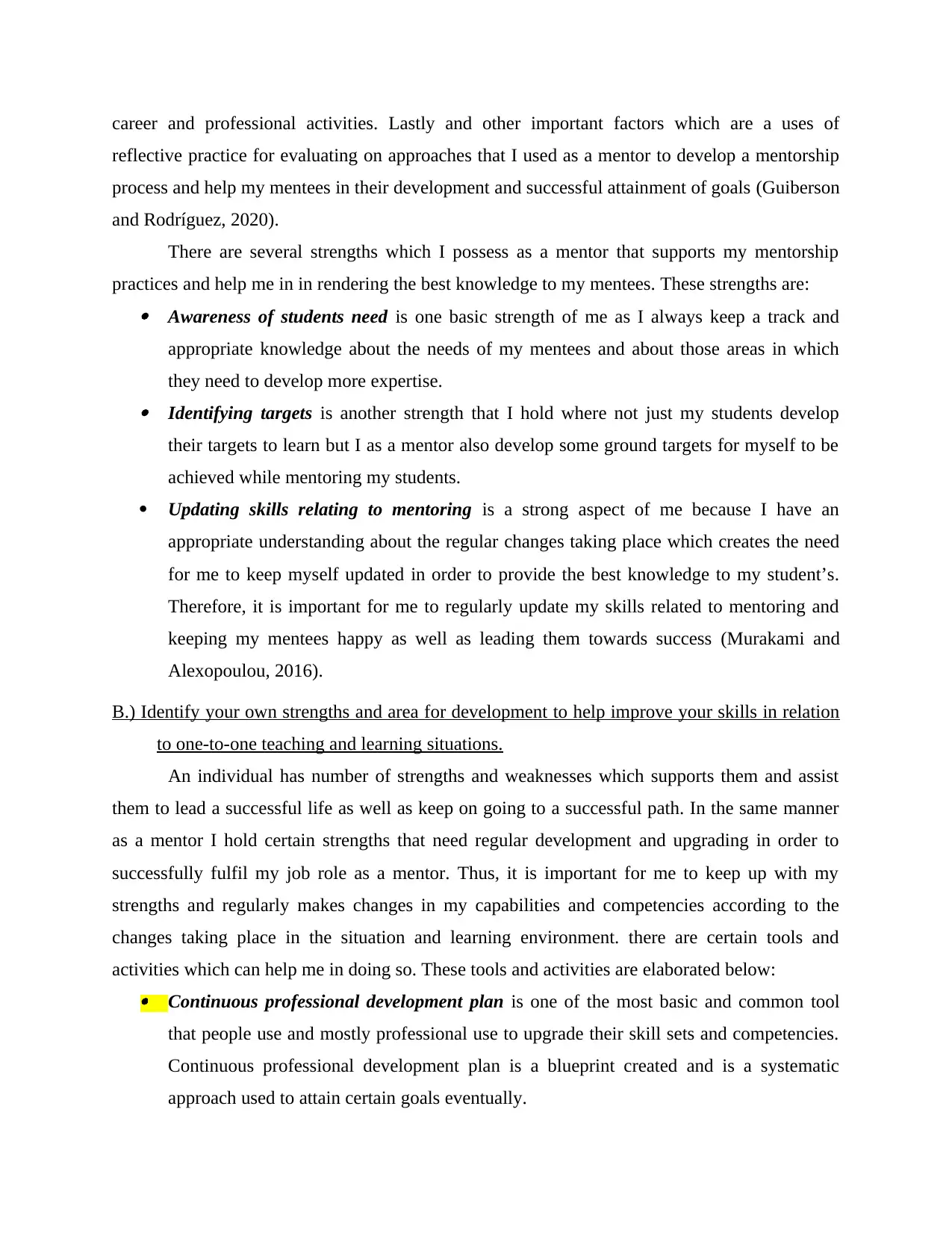
career and professional activities. Lastly and other important factors which are a uses of
reflective practice for evaluating on approaches that I used as a mentor to develop a mentorship
process and help my mentees in their development and successful attainment of goals (Guiberson
and Rodríguez, 2020).
There are several strengths which I possess as a mentor that supports my mentorship
practices and help me in in rendering the best knowledge to my mentees. These strengths are: Awareness of students need is one basic strength of me as I always keep a track and
appropriate knowledge about the needs of my mentees and about those areas in which
they need to develop more expertise. Identifying targets is another strength that I hold where not just my students develop
their targets to learn but I as a mentor also develop some ground targets for myself to be
achieved while mentoring my students.
Updating skills relating to mentoring is a strong aspect of me because I have an
appropriate understanding about the regular changes taking place which creates the need
for me to keep myself updated in order to provide the best knowledge to my student’s.
Therefore, it is important for me to regularly update my skills related to mentoring and
keeping my mentees happy as well as leading them towards success (Murakami and
Alexopoulou, 2016).
B.) Identify your own strengths and area for development to help improve your skills in relation
to one-to-one teaching and learning situations.
An individual has number of strengths and weaknesses which supports them and assist
them to lead a successful life as well as keep on going to a successful path. In the same manner
as a mentor I hold certain strengths that need regular development and upgrading in order to
successfully fulfil my job role as a mentor. Thus, it is important for me to keep up with my
strengths and regularly makes changes in my capabilities and competencies according to the
changes taking place in the situation and learning environment. there are certain tools and
activities which can help me in doing so. These tools and activities are elaborated below: Continuous professional development plan is one of the most basic and common tool
that people use and mostly professional use to upgrade their skill sets and competencies.
Continuous professional development plan is a blueprint created and is a systematic
approach used to attain certain goals eventually.
reflective practice for evaluating on approaches that I used as a mentor to develop a mentorship
process and help my mentees in their development and successful attainment of goals (Guiberson
and Rodríguez, 2020).
There are several strengths which I possess as a mentor that supports my mentorship
practices and help me in in rendering the best knowledge to my mentees. These strengths are: Awareness of students need is one basic strength of me as I always keep a track and
appropriate knowledge about the needs of my mentees and about those areas in which
they need to develop more expertise. Identifying targets is another strength that I hold where not just my students develop
their targets to learn but I as a mentor also develop some ground targets for myself to be
achieved while mentoring my students.
Updating skills relating to mentoring is a strong aspect of me because I have an
appropriate understanding about the regular changes taking place which creates the need
for me to keep myself updated in order to provide the best knowledge to my student’s.
Therefore, it is important for me to regularly update my skills related to mentoring and
keeping my mentees happy as well as leading them towards success (Murakami and
Alexopoulou, 2016).
B.) Identify your own strengths and area for development to help improve your skills in relation
to one-to-one teaching and learning situations.
An individual has number of strengths and weaknesses which supports them and assist
them to lead a successful life as well as keep on going to a successful path. In the same manner
as a mentor I hold certain strengths that need regular development and upgrading in order to
successfully fulfil my job role as a mentor. Thus, it is important for me to keep up with my
strengths and regularly makes changes in my capabilities and competencies according to the
changes taking place in the situation and learning environment. there are certain tools and
activities which can help me in doing so. These tools and activities are elaborated below: Continuous professional development plan is one of the most basic and common tool
that people use and mostly professional use to upgrade their skill sets and competencies.
Continuous professional development plan is a blueprint created and is a systematic
approach used to attain certain goals eventually.
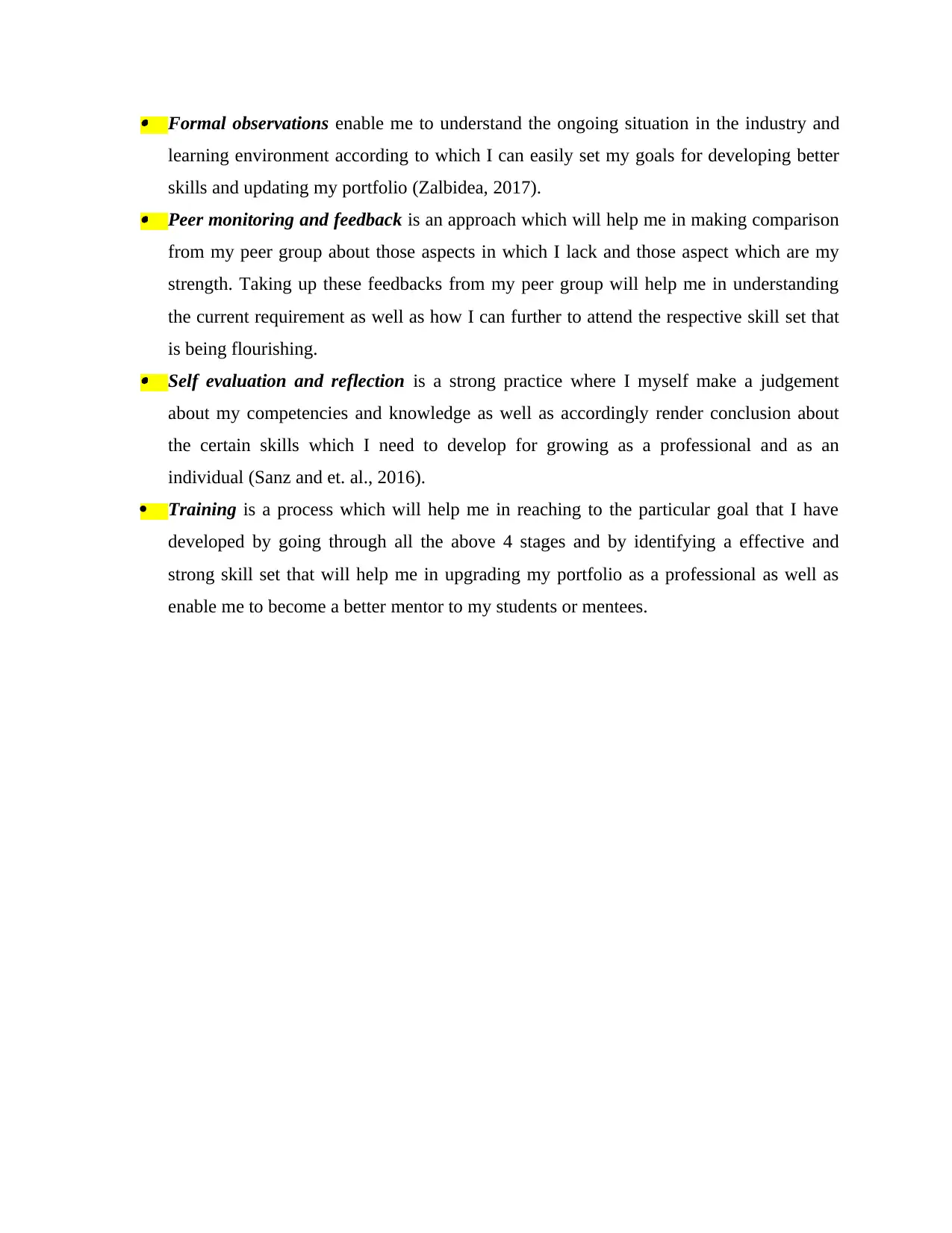
Formal observations enable me to understand the ongoing situation in the industry and
learning environment according to which I can easily set my goals for developing better
skills and updating my portfolio (Zalbidea, 2017). Peer monitoring and feedback is an approach which will help me in making comparison
from my peer group about those aspects in which I lack and those aspect which are my
strength. Taking up these feedbacks from my peer group will help me in understanding
the current requirement as well as how I can further to attend the respective skill set that
is being flourishing. Self evaluation and reflection is a strong practice where I myself make a judgement
about my competencies and knowledge as well as accordingly render conclusion about
the certain skills which I need to develop for growing as a professional and as an
individual (Sanz and et. al., 2016).
Training is a process which will help me in reaching to the particular goal that I have
developed by going through all the above 4 stages and by identifying a effective and
strong skill set that will help me in upgrading my portfolio as a professional as well as
enable me to become a better mentor to my students or mentees.
learning environment according to which I can easily set my goals for developing better
skills and updating my portfolio (Zalbidea, 2017). Peer monitoring and feedback is an approach which will help me in making comparison
from my peer group about those aspects in which I lack and those aspect which are my
strength. Taking up these feedbacks from my peer group will help me in understanding
the current requirement as well as how I can further to attend the respective skill set that
is being flourishing. Self evaluation and reflection is a strong practice where I myself make a judgement
about my competencies and knowledge as well as accordingly render conclusion about
the certain skills which I need to develop for growing as a professional and as an
individual (Sanz and et. al., 2016).
Training is a process which will help me in reaching to the particular goal that I have
developed by going through all the above 4 stages and by identifying a effective and
strong skill set that will help me in upgrading my portfolio as a professional as well as
enable me to become a better mentor to my students or mentees.
Paraphrase This Document
Need a fresh take? Get an instant paraphrase of this document with our AI Paraphraser
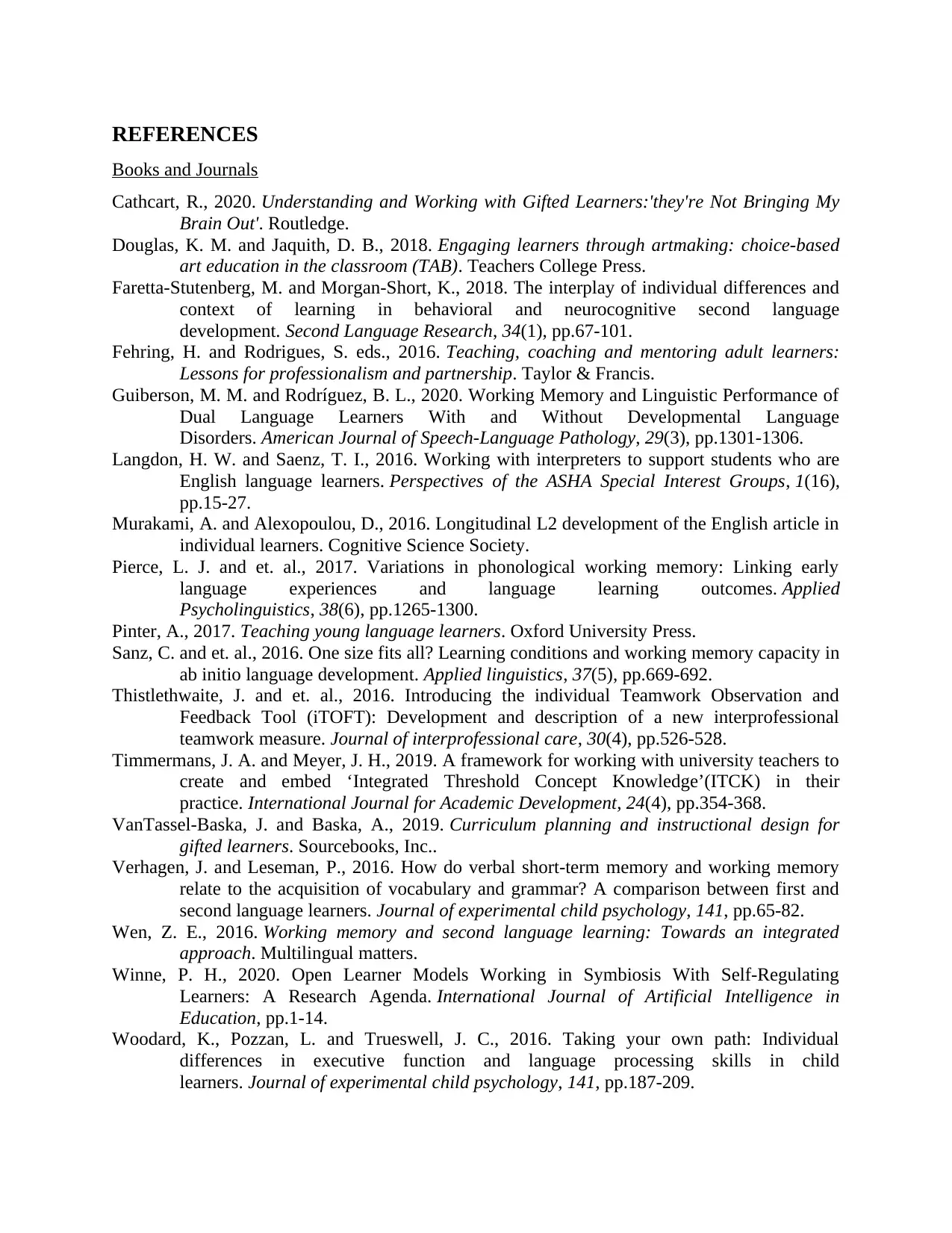
REFERENCES
Books and Journals
Cathcart, R., 2020. Understanding and Working with Gifted Learners:'they're Not Bringing My
Brain Out'. Routledge.
Douglas, K. M. and Jaquith, D. B., 2018. Engaging learners through artmaking: choice-based
art education in the classroom (TAB). Teachers College Press.
Faretta-Stutenberg, M. and Morgan-Short, K., 2018. The interplay of individual differences and
context of learning in behavioral and neurocognitive second language
development. Second Language Research, 34(1), pp.67-101.
Fehring, H. and Rodrigues, S. eds., 2016. Teaching, coaching and mentoring adult learners:
Lessons for professionalism and partnership. Taylor & Francis.
Guiberson, M. M. and Rodríguez, B. L., 2020. Working Memory and Linguistic Performance of
Dual Language Learners With and Without Developmental Language
Disorders. American Journal of Speech-Language Pathology, 29(3), pp.1301-1306.
Langdon, H. W. and Saenz, T. I., 2016. Working with interpreters to support students who are
English language learners. Perspectives of the ASHA Special Interest Groups, 1(16),
pp.15-27.
Murakami, A. and Alexopoulou, D., 2016. Longitudinal L2 development of the English article in
individual learners. Cognitive Science Society.
Pierce, L. J. and et. al., 2017. Variations in phonological working memory: Linking early
language experiences and language learning outcomes. Applied
Psycholinguistics, 38(6), pp.1265-1300.
Pinter, A., 2017. Teaching young language learners. Oxford University Press.
Sanz, C. and et. al., 2016. One size fits all? Learning conditions and working memory capacity in
ab initio language development. Applied linguistics, 37(5), pp.669-692.
Thistlethwaite, J. and et. al., 2016. Introducing the individual Teamwork Observation and
Feedback Tool (iTOFT): Development and description of a new interprofessional
teamwork measure. Journal of interprofessional care, 30(4), pp.526-528.
Timmermans, J. A. and Meyer, J. H., 2019. A framework for working with university teachers to
create and embed ‘Integrated Threshold Concept Knowledge’(ITCK) in their
practice. International Journal for Academic Development, 24(4), pp.354-368.
VanTassel-Baska, J. and Baska, A., 2019. Curriculum planning and instructional design for
gifted learners. Sourcebooks, Inc..
Verhagen, J. and Leseman, P., 2016. How do verbal short-term memory and working memory
relate to the acquisition of vocabulary and grammar? A comparison between first and
second language learners. Journal of experimental child psychology, 141, pp.65-82.
Wen, Z. E., 2016. Working memory and second language learning: Towards an integrated
approach. Multilingual matters.
Winne, P. H., 2020. Open Learner Models Working in Symbiosis With Self-Regulating
Learners: A Research Agenda. International Journal of Artificial Intelligence in
Education, pp.1-14.
Woodard, K., Pozzan, L. and Trueswell, J. C., 2016. Taking your own path: Individual
differences in executive function and language processing skills in child
learners. Journal of experimental child psychology, 141, pp.187-209.
Books and Journals
Cathcart, R., 2020. Understanding and Working with Gifted Learners:'they're Not Bringing My
Brain Out'. Routledge.
Douglas, K. M. and Jaquith, D. B., 2018. Engaging learners through artmaking: choice-based
art education in the classroom (TAB). Teachers College Press.
Faretta-Stutenberg, M. and Morgan-Short, K., 2018. The interplay of individual differences and
context of learning in behavioral and neurocognitive second language
development. Second Language Research, 34(1), pp.67-101.
Fehring, H. and Rodrigues, S. eds., 2016. Teaching, coaching and mentoring adult learners:
Lessons for professionalism and partnership. Taylor & Francis.
Guiberson, M. M. and Rodríguez, B. L., 2020. Working Memory and Linguistic Performance of
Dual Language Learners With and Without Developmental Language
Disorders. American Journal of Speech-Language Pathology, 29(3), pp.1301-1306.
Langdon, H. W. and Saenz, T. I., 2016. Working with interpreters to support students who are
English language learners. Perspectives of the ASHA Special Interest Groups, 1(16),
pp.15-27.
Murakami, A. and Alexopoulou, D., 2016. Longitudinal L2 development of the English article in
individual learners. Cognitive Science Society.
Pierce, L. J. and et. al., 2017. Variations in phonological working memory: Linking early
language experiences and language learning outcomes. Applied
Psycholinguistics, 38(6), pp.1265-1300.
Pinter, A., 2017. Teaching young language learners. Oxford University Press.
Sanz, C. and et. al., 2016. One size fits all? Learning conditions and working memory capacity in
ab initio language development. Applied linguistics, 37(5), pp.669-692.
Thistlethwaite, J. and et. al., 2016. Introducing the individual Teamwork Observation and
Feedback Tool (iTOFT): Development and description of a new interprofessional
teamwork measure. Journal of interprofessional care, 30(4), pp.526-528.
Timmermans, J. A. and Meyer, J. H., 2019. A framework for working with university teachers to
create and embed ‘Integrated Threshold Concept Knowledge’(ITCK) in their
practice. International Journal for Academic Development, 24(4), pp.354-368.
VanTassel-Baska, J. and Baska, A., 2019. Curriculum planning and instructional design for
gifted learners. Sourcebooks, Inc..
Verhagen, J. and Leseman, P., 2016. How do verbal short-term memory and working memory
relate to the acquisition of vocabulary and grammar? A comparison between first and
second language learners. Journal of experimental child psychology, 141, pp.65-82.
Wen, Z. E., 2016. Working memory and second language learning: Towards an integrated
approach. Multilingual matters.
Winne, P. H., 2020. Open Learner Models Working in Symbiosis With Self-Regulating
Learners: A Research Agenda. International Journal of Artificial Intelligence in
Education, pp.1-14.
Woodard, K., Pozzan, L. and Trueswell, J. C., 2016. Taking your own path: Individual
differences in executive function and language processing skills in child
learners. Journal of experimental child psychology, 141, pp.187-209.
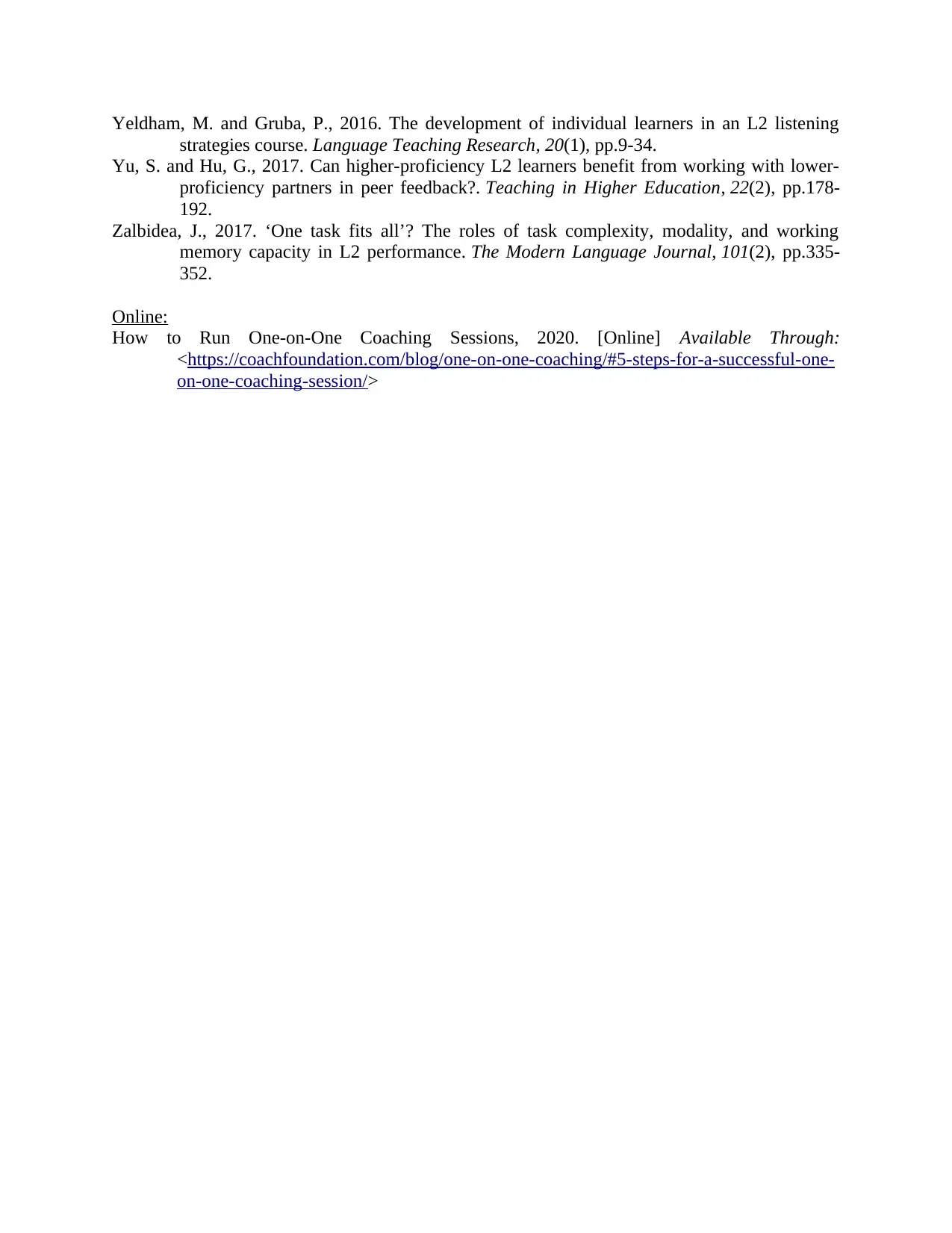
Yeldham, M. and Gruba, P., 2016. The development of individual learners in an L2 listening
strategies course. Language Teaching Research, 20(1), pp.9-34.
Yu, S. and Hu, G., 2017. Can higher-proficiency L2 learners benefit from working with lower-
proficiency partners in peer feedback?. Teaching in Higher Education, 22(2), pp.178-
192.
Zalbidea, J., 2017. ‘One task fits all’? The roles of task complexity, modality, and working
memory capacity in L2 performance. The Modern Language Journal, 101(2), pp.335-
352.
Online:
How to Run One-on-One Coaching Sessions, 2020. [Online] Available Through:
<https://coachfoundation.com/blog/one-on-one-coaching/#5-steps-for-a-successful-one-
on-one-coaching-session/>
strategies course. Language Teaching Research, 20(1), pp.9-34.
Yu, S. and Hu, G., 2017. Can higher-proficiency L2 learners benefit from working with lower-
proficiency partners in peer feedback?. Teaching in Higher Education, 22(2), pp.178-
192.
Zalbidea, J., 2017. ‘One task fits all’? The roles of task complexity, modality, and working
memory capacity in L2 performance. The Modern Language Journal, 101(2), pp.335-
352.
Online:
How to Run One-on-One Coaching Sessions, 2020. [Online] Available Through:
<https://coachfoundation.com/blog/one-on-one-coaching/#5-steps-for-a-successful-one-
on-one-coaching-session/>
1 out of 15
Related Documents
Your All-in-One AI-Powered Toolkit for Academic Success.
+13062052269
info@desklib.com
Available 24*7 on WhatsApp / Email
![[object Object]](/_next/static/media/star-bottom.7253800d.svg)
Unlock your academic potential
© 2024 | Zucol Services PVT LTD | All rights reserved.





